MGMT1101: Tesco's Strategic Management, SWOT, and Business Analysis
VerifiedAdded on 2023/04/23
|10
|1832
|268
Report
AI Summary
This report provides an analysis of Tesco's strategic management, examining its vision, mission, and organizational structure. It identifies Tesco's strengths, weaknesses, opportunities, and threats through a SWOT analysis. The report discusses Tesco's corporate-level strategies, including its two-tier expansion and growth strategies, as well as its business-level strategies, focusing on cost leadership and differentiation. Segmentation and targeting practices adopted by Tesco are also presented. The analysis concludes that Tesco is a leading global retailer that has adopted various strategies to adapt to changing market demands and maintain a competitive advantage.
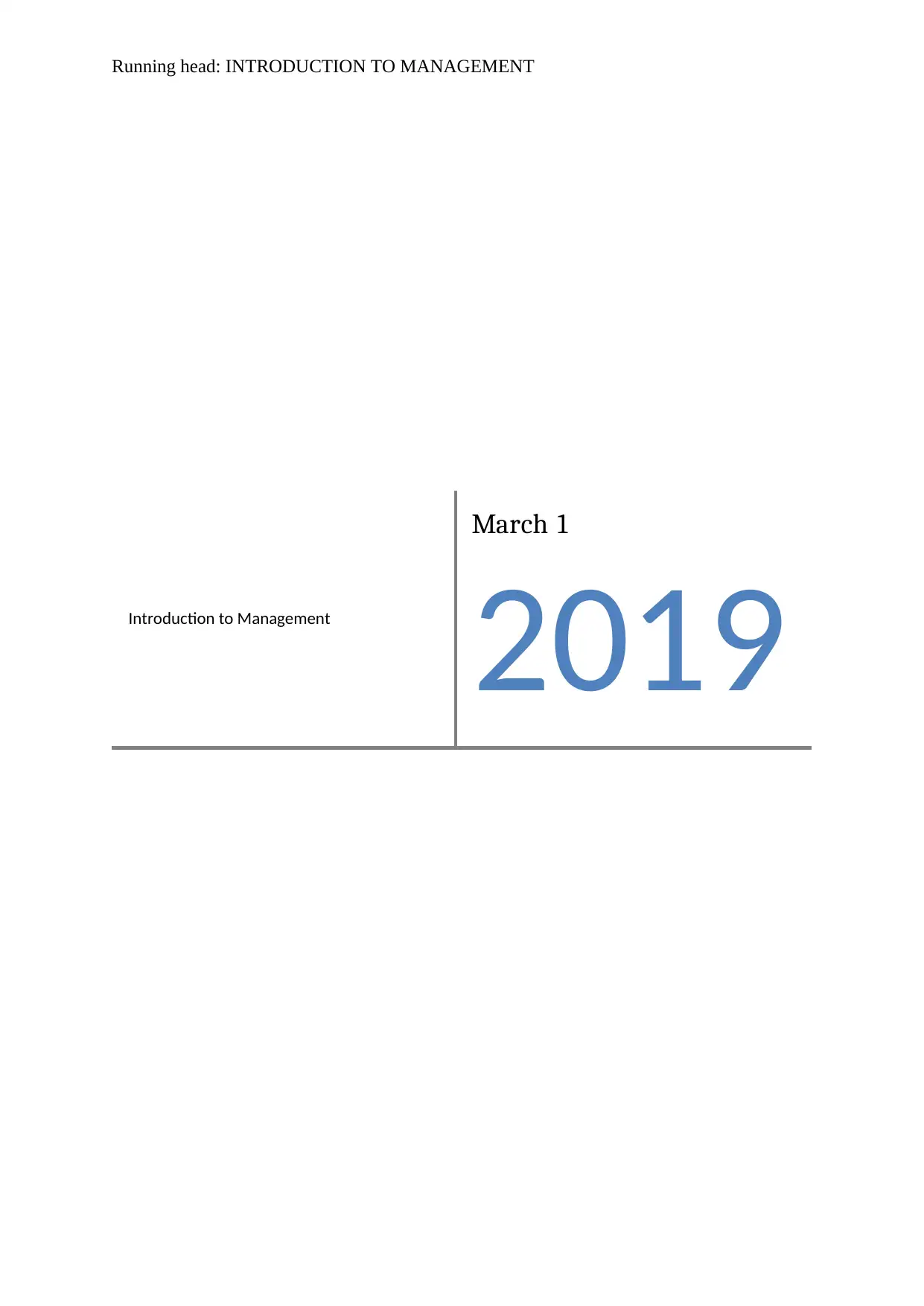
Running head: INTRODUCTION TO MANAGEMENT
Introduction to Management
March 1
2019
Introduction to Management
March 1
2019
Paraphrase This Document
Need a fresh take? Get an instant paraphrase of this document with our AI Paraphraser
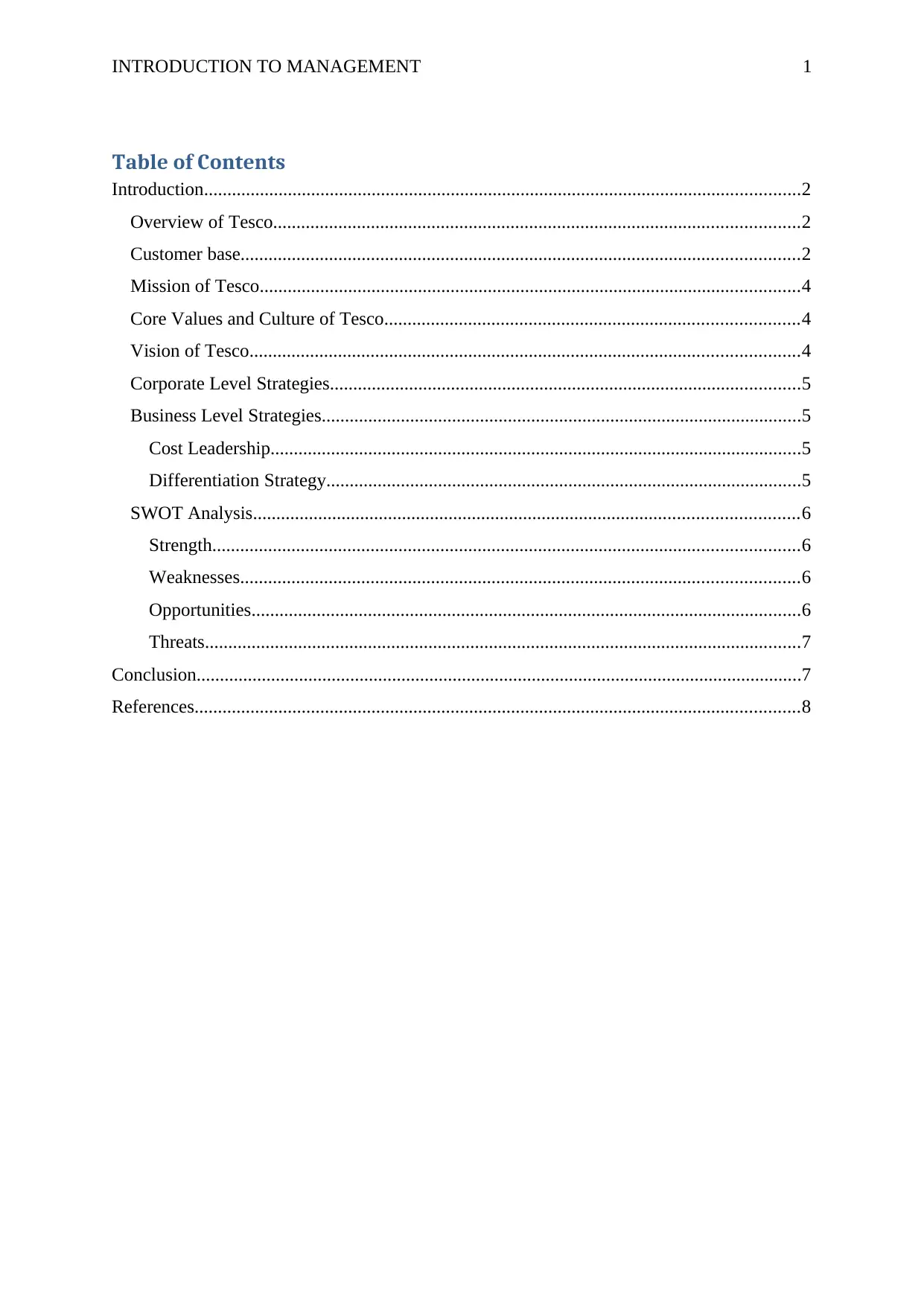
INTRODUCTION TO MANAGEMENT 1
Table of Contents
Introduction................................................................................................................................2
Overview of Tesco.................................................................................................................2
Customer base........................................................................................................................2
Mission of Tesco....................................................................................................................4
Core Values and Culture of Tesco.........................................................................................4
Vision of Tesco......................................................................................................................4
Corporate Level Strategies.....................................................................................................5
Business Level Strategies.......................................................................................................5
Cost Leadership..................................................................................................................5
Differentiation Strategy......................................................................................................5
SWOT Analysis.....................................................................................................................6
Strength..............................................................................................................................6
Weaknesses........................................................................................................................6
Opportunities......................................................................................................................6
Threats................................................................................................................................7
Conclusion..................................................................................................................................7
References..................................................................................................................................8
Table of Contents
Introduction................................................................................................................................2
Overview of Tesco.................................................................................................................2
Customer base........................................................................................................................2
Mission of Tesco....................................................................................................................4
Core Values and Culture of Tesco.........................................................................................4
Vision of Tesco......................................................................................................................4
Corporate Level Strategies.....................................................................................................5
Business Level Strategies.......................................................................................................5
Cost Leadership..................................................................................................................5
Differentiation Strategy......................................................................................................5
SWOT Analysis.....................................................................................................................6
Strength..............................................................................................................................6
Weaknesses........................................................................................................................6
Opportunities......................................................................................................................6
Threats................................................................................................................................7
Conclusion..................................................................................................................................7
References..................................................................................................................................8
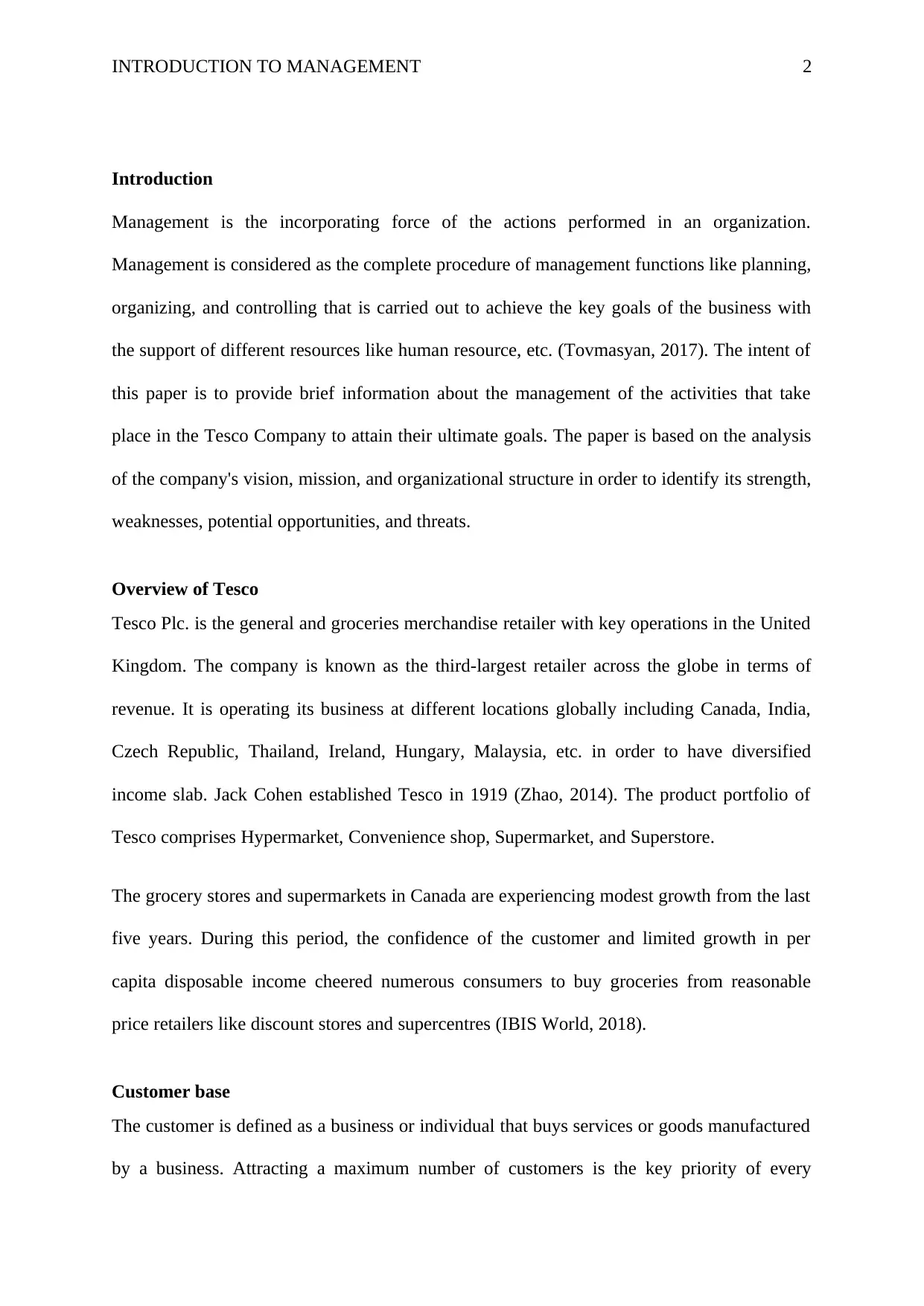
INTRODUCTION TO MANAGEMENT 2
Introduction
Management is the incorporating force of the actions performed in an organization.
Management is considered as the complete procedure of management functions like planning,
organizing, and controlling that is carried out to achieve the key goals of the business with
the support of different resources like human resource, etc. (Tovmasyan, 2017). The intent of
this paper is to provide brief information about the management of the activities that take
place in the Tesco Company to attain their ultimate goals. The paper is based on the analysis
of the company's vision, mission, and organizational structure in order to identify its strength,
weaknesses, potential opportunities, and threats.
Overview of Tesco
Tesco Plc. is the general and groceries merchandise retailer with key operations in the United
Kingdom. The company is known as the third-largest retailer across the globe in terms of
revenue. It is operating its business at different locations globally including Canada, India,
Czech Republic, Thailand, Ireland, Hungary, Malaysia, etc. in order to have diversified
income slab. Jack Cohen established Tesco in 1919 (Zhao, 2014). The product portfolio of
Tesco comprises Hypermarket, Convenience shop, Supermarket, and Superstore.
The grocery stores and supermarkets in Canada are experiencing modest growth from the last
five years. During this period, the confidence of the customer and limited growth in per
capita disposable income cheered numerous consumers to buy groceries from reasonable
price retailers like discount stores and supercentres (IBIS World, 2018).
Customer base
The customer is defined as a business or individual that buys services or goods manufactured
by a business. Attracting a maximum number of customers is the key priority of every
Introduction
Management is the incorporating force of the actions performed in an organization.
Management is considered as the complete procedure of management functions like planning,
organizing, and controlling that is carried out to achieve the key goals of the business with
the support of different resources like human resource, etc. (Tovmasyan, 2017). The intent of
this paper is to provide brief information about the management of the activities that take
place in the Tesco Company to attain their ultimate goals. The paper is based on the analysis
of the company's vision, mission, and organizational structure in order to identify its strength,
weaknesses, potential opportunities, and threats.
Overview of Tesco
Tesco Plc. is the general and groceries merchandise retailer with key operations in the United
Kingdom. The company is known as the third-largest retailer across the globe in terms of
revenue. It is operating its business at different locations globally including Canada, India,
Czech Republic, Thailand, Ireland, Hungary, Malaysia, etc. in order to have diversified
income slab. Jack Cohen established Tesco in 1919 (Zhao, 2014). The product portfolio of
Tesco comprises Hypermarket, Convenience shop, Supermarket, and Superstore.
The grocery stores and supermarkets in Canada are experiencing modest growth from the last
five years. During this period, the confidence of the customer and limited growth in per
capita disposable income cheered numerous consumers to buy groceries from reasonable
price retailers like discount stores and supercentres (IBIS World, 2018).
Customer base
The customer is defined as a business or individual that buys services or goods manufactured
by a business. Attracting a maximum number of customers is the key priority of every
⊘ This is a preview!⊘
Do you want full access?
Subscribe today to unlock all pages.

Trusted by 1+ million students worldwide
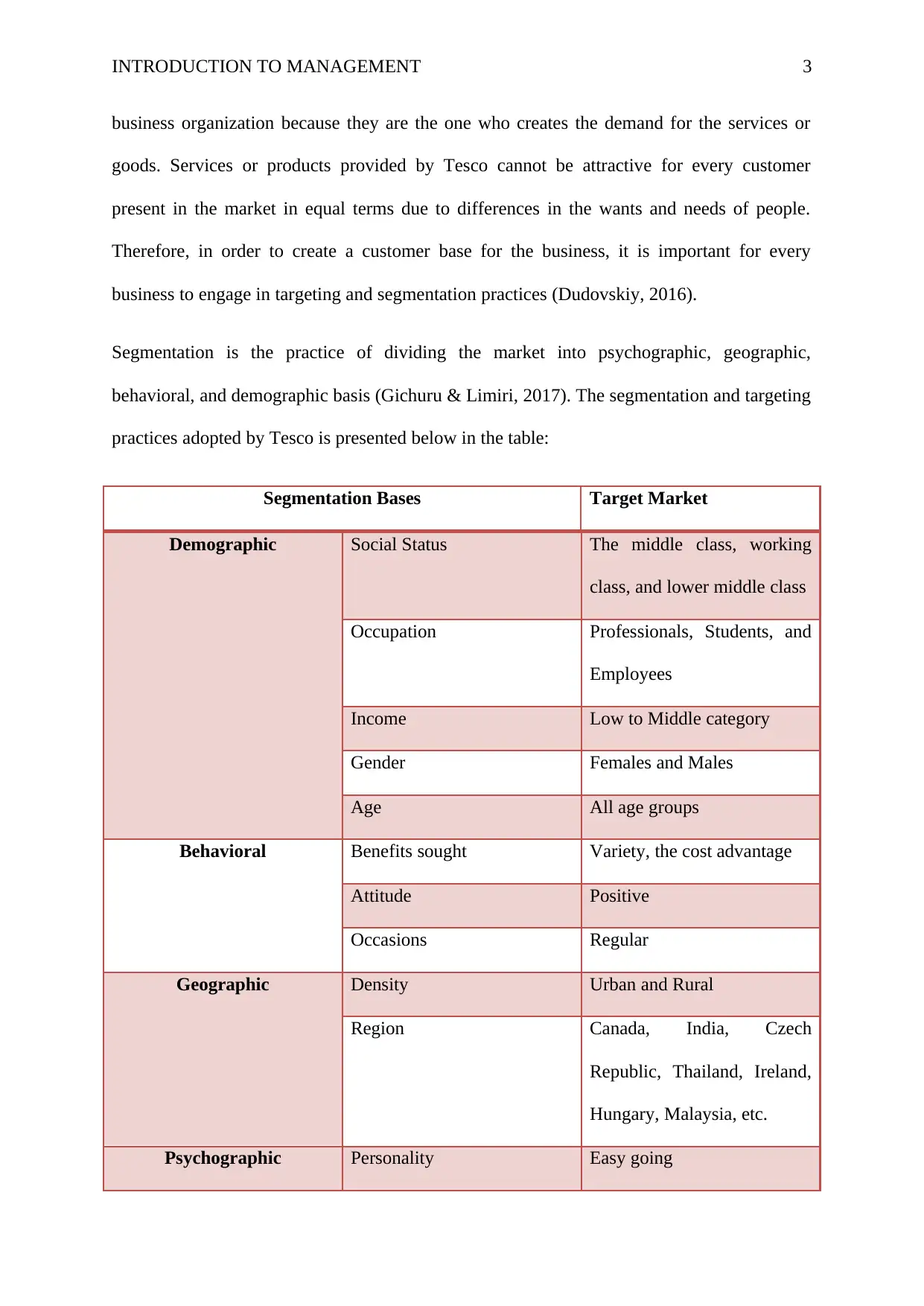
INTRODUCTION TO MANAGEMENT 3
business organization because they are the one who creates the demand for the services or
goods. Services or products provided by Tesco cannot be attractive for every customer
present in the market in equal terms due to differences in the wants and needs of people.
Therefore, in order to create a customer base for the business, it is important for every
business to engage in targeting and segmentation practices (Dudovskiy, 2016).
Segmentation is the practice of dividing the market into psychographic, geographic,
behavioral, and demographic basis (Gichuru & Limiri, 2017). The segmentation and targeting
practices adopted by Tesco is presented below in the table:
Segmentation Bases Target Market
Demographic Social Status The middle class, working
class, and lower middle class
Occupation Professionals, Students, and
Employees
Income Low to Middle category
Gender Females and Males
Age All age groups
Behavioral Benefits sought Variety, the cost advantage
Attitude Positive
Occasions Regular
Geographic Density Urban and Rural
Region Canada, India, Czech
Republic, Thailand, Ireland,
Hungary, Malaysia, etc.
Psychographic Personality Easy going
business organization because they are the one who creates the demand for the services or
goods. Services or products provided by Tesco cannot be attractive for every customer
present in the market in equal terms due to differences in the wants and needs of people.
Therefore, in order to create a customer base for the business, it is important for every
business to engage in targeting and segmentation practices (Dudovskiy, 2016).
Segmentation is the practice of dividing the market into psychographic, geographic,
behavioral, and demographic basis (Gichuru & Limiri, 2017). The segmentation and targeting
practices adopted by Tesco is presented below in the table:
Segmentation Bases Target Market
Demographic Social Status The middle class, working
class, and lower middle class
Occupation Professionals, Students, and
Employees
Income Low to Middle category
Gender Females and Males
Age All age groups
Behavioral Benefits sought Variety, the cost advantage
Attitude Positive
Occasions Regular
Geographic Density Urban and Rural
Region Canada, India, Czech
Republic, Thailand, Ireland,
Hungary, Malaysia, etc.
Psychographic Personality Easy going
Paraphrase This Document
Need a fresh take? Get an instant paraphrase of this document with our AI Paraphraser
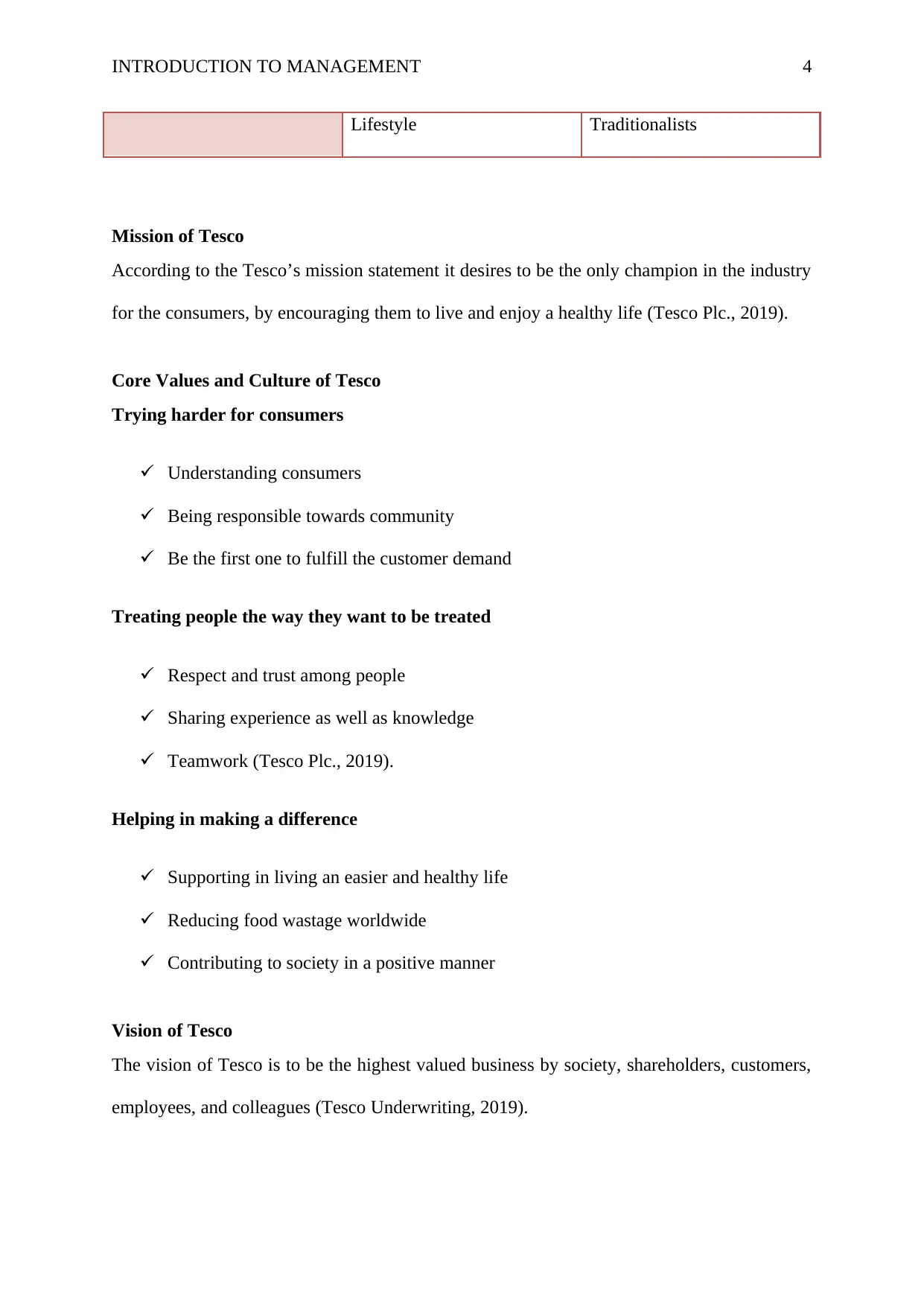
INTRODUCTION TO MANAGEMENT 4
Lifestyle Traditionalists
Mission of Tesco
According to the Tesco’s mission statement it desires to be the only champion in the industry
for the consumers, by encouraging them to live and enjoy a healthy life (Tesco Plc., 2019).
Core Values and Culture of Tesco
Trying harder for consumers
Understanding consumers
Being responsible towards community
Be the first one to fulfill the customer demand
Treating people the way they want to be treated
Respect and trust among people
Sharing experience as well as knowledge
Teamwork (Tesco Plc., 2019).
Helping in making a difference
Supporting in living an easier and healthy life
Reducing food wastage worldwide
Contributing to society in a positive manner
Vision of Tesco
The vision of Tesco is to be the highest valued business by society, shareholders, customers,
employees, and colleagues (Tesco Underwriting, 2019).
Lifestyle Traditionalists
Mission of Tesco
According to the Tesco’s mission statement it desires to be the only champion in the industry
for the consumers, by encouraging them to live and enjoy a healthy life (Tesco Plc., 2019).
Core Values and Culture of Tesco
Trying harder for consumers
Understanding consumers
Being responsible towards community
Be the first one to fulfill the customer demand
Treating people the way they want to be treated
Respect and trust among people
Sharing experience as well as knowledge
Teamwork (Tesco Plc., 2019).
Helping in making a difference
Supporting in living an easier and healthy life
Reducing food wastage worldwide
Contributing to society in a positive manner
Vision of Tesco
The vision of Tesco is to be the highest valued business by society, shareholders, customers,
employees, and colleagues (Tesco Underwriting, 2019).
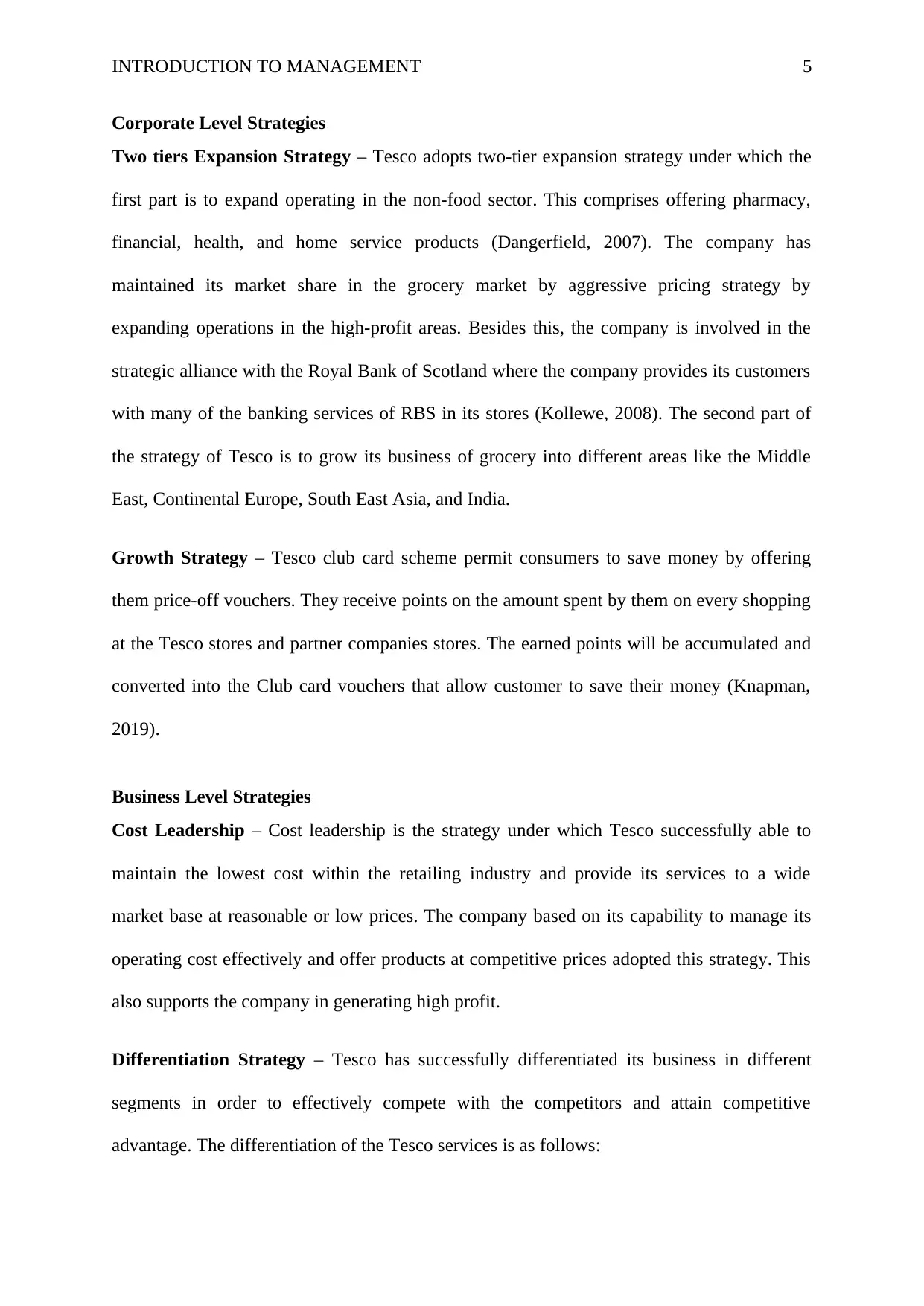
INTRODUCTION TO MANAGEMENT 5
Corporate Level Strategies
Two tiers Expansion Strategy – Tesco adopts two-tier expansion strategy under which the
first part is to expand operating in the non-food sector. This comprises offering pharmacy,
financial, health, and home service products (Dangerfield, 2007). The company has
maintained its market share in the grocery market by aggressive pricing strategy by
expanding operations in the high-profit areas. Besides this, the company is involved in the
strategic alliance with the Royal Bank of Scotland where the company provides its customers
with many of the banking services of RBS in its stores (Kollewe, 2008). The second part of
the strategy of Tesco is to grow its business of grocery into different areas like the Middle
East, Continental Europe, South East Asia, and India.
Growth Strategy – Tesco club card scheme permit consumers to save money by offering
them price-off vouchers. They receive points on the amount spent by them on every shopping
at the Tesco stores and partner companies stores. The earned points will be accumulated and
converted into the Club card vouchers that allow customer to save their money (Knapman,
2019).
Business Level Strategies
Cost Leadership – Cost leadership is the strategy under which Tesco successfully able to
maintain the lowest cost within the retailing industry and provide its services to a wide
market base at reasonable or low prices. The company based on its capability to manage its
operating cost effectively and offer products at competitive prices adopted this strategy. This
also supports the company in generating high profit.
Differentiation Strategy – Tesco has successfully differentiated its business in different
segments in order to effectively compete with the competitors and attain competitive
advantage. The differentiation of the Tesco services is as follows:
Corporate Level Strategies
Two tiers Expansion Strategy – Tesco adopts two-tier expansion strategy under which the
first part is to expand operating in the non-food sector. This comprises offering pharmacy,
financial, health, and home service products (Dangerfield, 2007). The company has
maintained its market share in the grocery market by aggressive pricing strategy by
expanding operations in the high-profit areas. Besides this, the company is involved in the
strategic alliance with the Royal Bank of Scotland where the company provides its customers
with many of the banking services of RBS in its stores (Kollewe, 2008). The second part of
the strategy of Tesco is to grow its business of grocery into different areas like the Middle
East, Continental Europe, South East Asia, and India.
Growth Strategy – Tesco club card scheme permit consumers to save money by offering
them price-off vouchers. They receive points on the amount spent by them on every shopping
at the Tesco stores and partner companies stores. The earned points will be accumulated and
converted into the Club card vouchers that allow customer to save their money (Knapman,
2019).
Business Level Strategies
Cost Leadership – Cost leadership is the strategy under which Tesco successfully able to
maintain the lowest cost within the retailing industry and provide its services to a wide
market base at reasonable or low prices. The company based on its capability to manage its
operating cost effectively and offer products at competitive prices adopted this strategy. This
also supports the company in generating high profit.
Differentiation Strategy – Tesco has successfully differentiated its business in different
segments in order to effectively compete with the competitors and attain competitive
advantage. The differentiation of the Tesco services is as follows:
⊘ This is a preview!⊘
Do you want full access?
Subscribe today to unlock all pages.

Trusted by 1+ million students worldwide
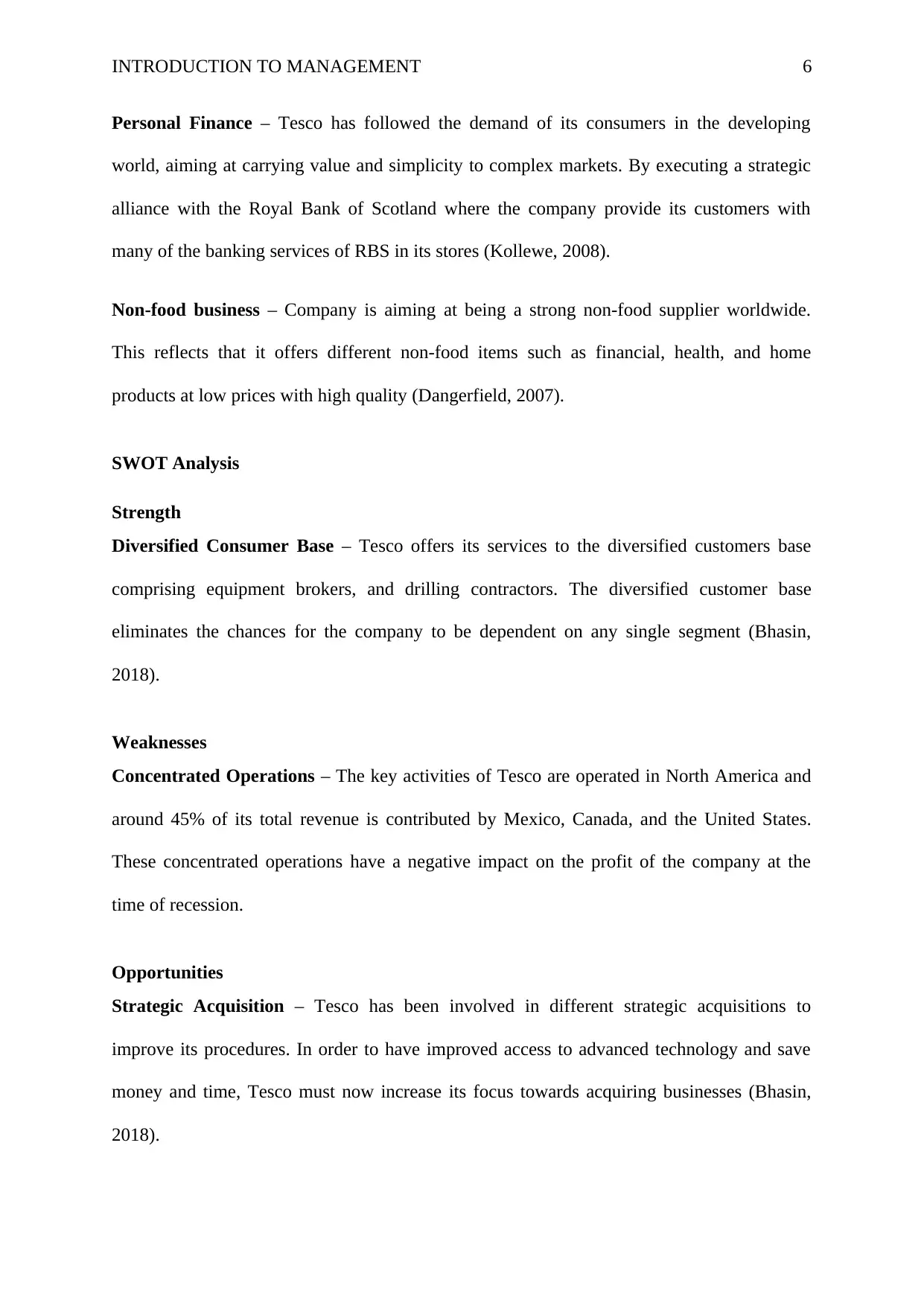
INTRODUCTION TO MANAGEMENT 6
Personal Finance – Tesco has followed the demand of its consumers in the developing
world, aiming at carrying value and simplicity to complex markets. By executing a strategic
alliance with the Royal Bank of Scotland where the company provide its customers with
many of the banking services of RBS in its stores (Kollewe, 2008).
Non-food business – Company is aiming at being a strong non-food supplier worldwide.
This reflects that it offers different non-food items such as financial, health, and home
products at low prices with high quality (Dangerfield, 2007).
SWOT Analysis
Strength
Diversified Consumer Base – Tesco offers its services to the diversified customers base
comprising equipment brokers, and drilling contractors. The diversified customer base
eliminates the chances for the company to be dependent on any single segment (Bhasin,
2018).
Weaknesses
Concentrated Operations – The key activities of Tesco are operated in North America and
around 45% of its total revenue is contributed by Mexico, Canada, and the United States.
These concentrated operations have a negative impact on the profit of the company at the
time of recession.
Opportunities
Strategic Acquisition – Tesco has been involved in different strategic acquisitions to
improve its procedures. In order to have improved access to advanced technology and save
money and time, Tesco must now increase its focus towards acquiring businesses (Bhasin,
2018).
Personal Finance – Tesco has followed the demand of its consumers in the developing
world, aiming at carrying value and simplicity to complex markets. By executing a strategic
alliance with the Royal Bank of Scotland where the company provide its customers with
many of the banking services of RBS in its stores (Kollewe, 2008).
Non-food business – Company is aiming at being a strong non-food supplier worldwide.
This reflects that it offers different non-food items such as financial, health, and home
products at low prices with high quality (Dangerfield, 2007).
SWOT Analysis
Strength
Diversified Consumer Base – Tesco offers its services to the diversified customers base
comprising equipment brokers, and drilling contractors. The diversified customer base
eliminates the chances for the company to be dependent on any single segment (Bhasin,
2018).
Weaknesses
Concentrated Operations – The key activities of Tesco are operated in North America and
around 45% of its total revenue is contributed by Mexico, Canada, and the United States.
These concentrated operations have a negative impact on the profit of the company at the
time of recession.
Opportunities
Strategic Acquisition – Tesco has been involved in different strategic acquisitions to
improve its procedures. In order to have improved access to advanced technology and save
money and time, Tesco must now increase its focus towards acquiring businesses (Bhasin,
2018).
Paraphrase This Document
Need a fresh take? Get an instant paraphrase of this document with our AI Paraphraser
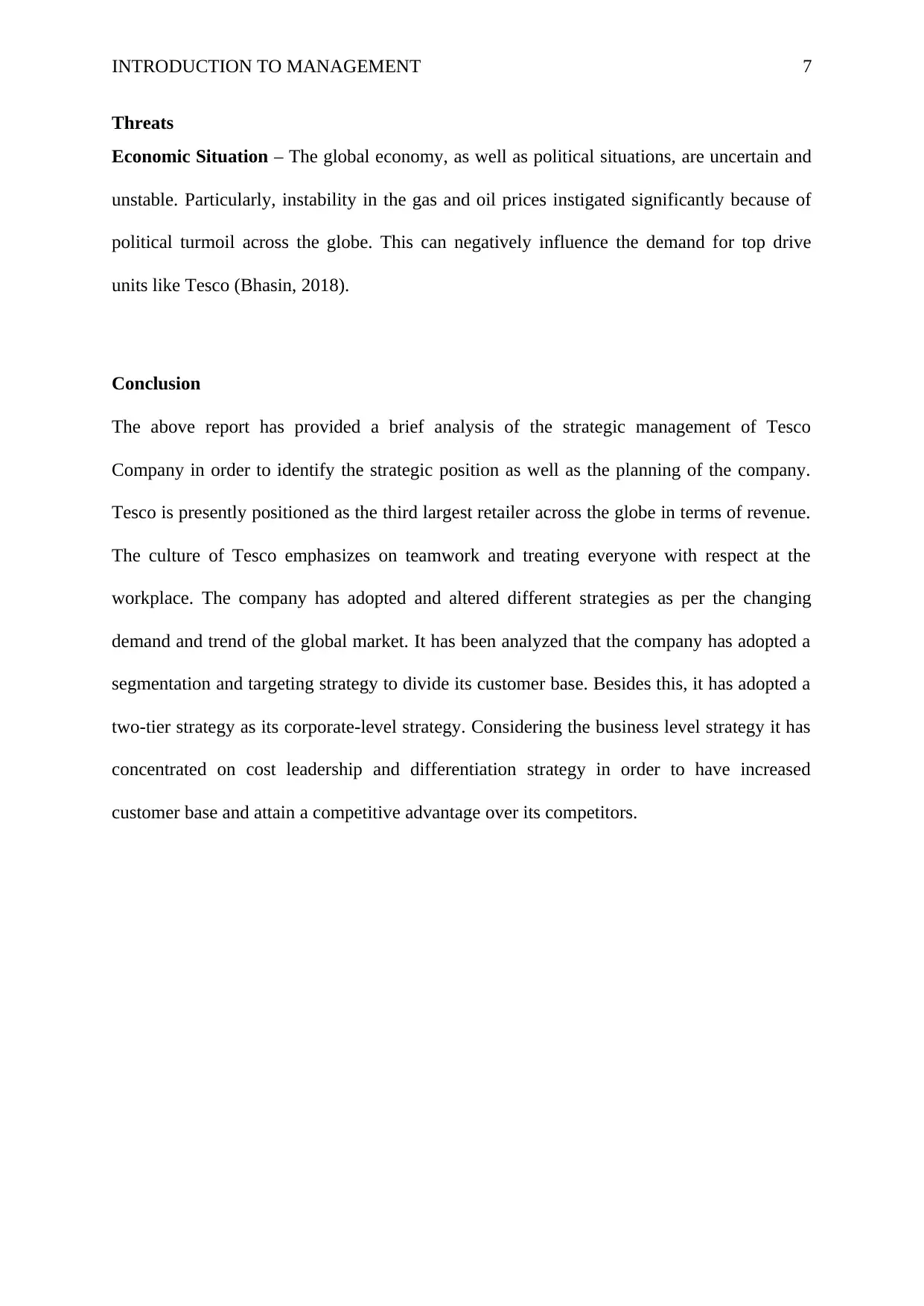
INTRODUCTION TO MANAGEMENT 7
Threats
Economic Situation – The global economy, as well as political situations, are uncertain and
unstable. Particularly, instability in the gas and oil prices instigated significantly because of
political turmoil across the globe. This can negatively influence the demand for top drive
units like Tesco (Bhasin, 2018).
Conclusion
The above report has provided a brief analysis of the strategic management of Tesco
Company in order to identify the strategic position as well as the planning of the company.
Tesco is presently positioned as the third largest retailer across the globe in terms of revenue.
The culture of Tesco emphasizes on teamwork and treating everyone with respect at the
workplace. The company has adopted and altered different strategies as per the changing
demand and trend of the global market. It has been analyzed that the company has adopted a
segmentation and targeting strategy to divide its customer base. Besides this, it has adopted a
two-tier strategy as its corporate-level strategy. Considering the business level strategy it has
concentrated on cost leadership and differentiation strategy in order to have increased
customer base and attain a competitive advantage over its competitors.
Threats
Economic Situation – The global economy, as well as political situations, are uncertain and
unstable. Particularly, instability in the gas and oil prices instigated significantly because of
political turmoil across the globe. This can negatively influence the demand for top drive
units like Tesco (Bhasin, 2018).
Conclusion
The above report has provided a brief analysis of the strategic management of Tesco
Company in order to identify the strategic position as well as the planning of the company.
Tesco is presently positioned as the third largest retailer across the globe in terms of revenue.
The culture of Tesco emphasizes on teamwork and treating everyone with respect at the
workplace. The company has adopted and altered different strategies as per the changing
demand and trend of the global market. It has been analyzed that the company has adopted a
segmentation and targeting strategy to divide its customer base. Besides this, it has adopted a
two-tier strategy as its corporate-level strategy. Considering the business level strategy it has
concentrated on cost leadership and differentiation strategy in order to have increased
customer base and attain a competitive advantage over its competitors.
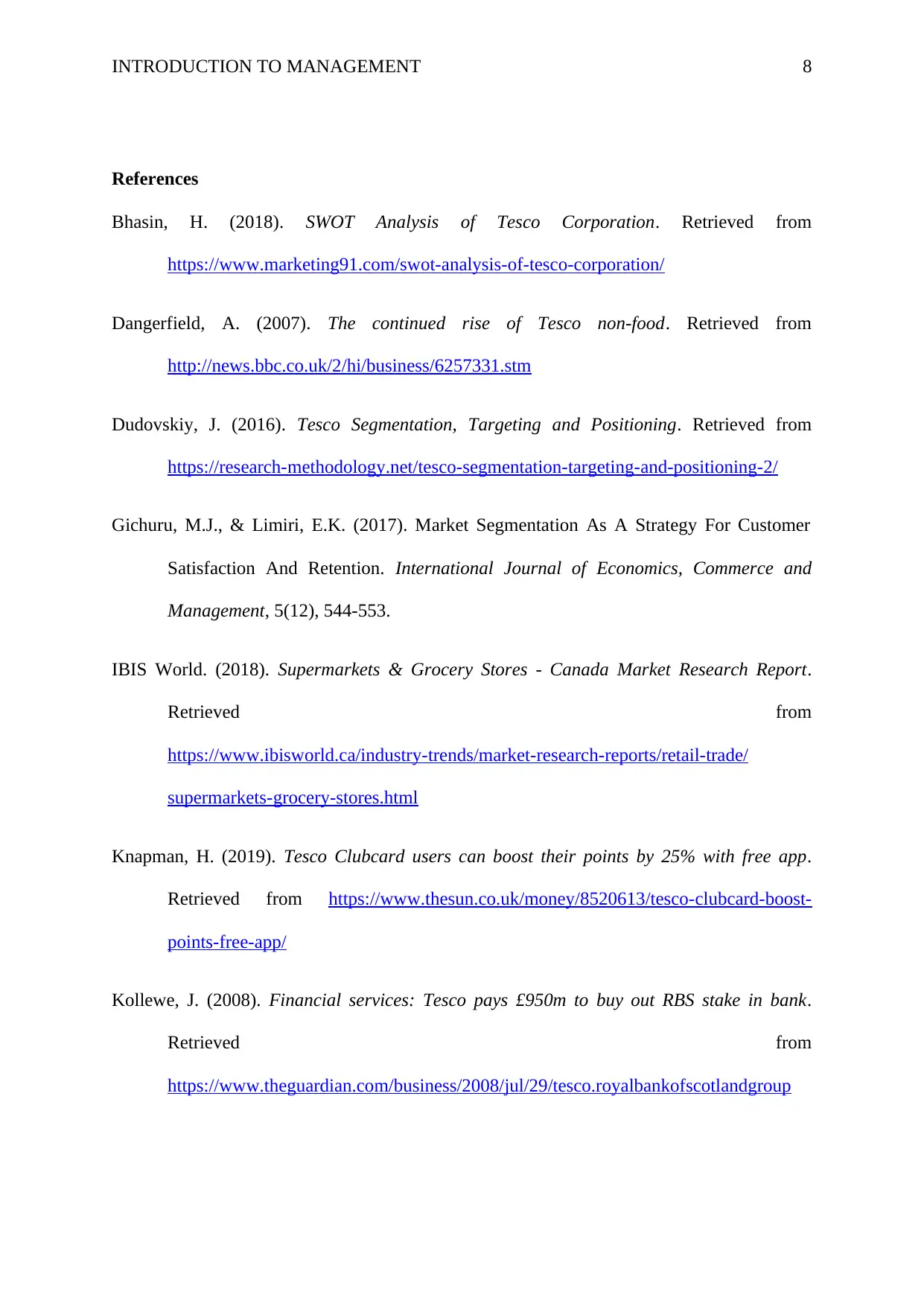
INTRODUCTION TO MANAGEMENT 8
References
Bhasin, H. (2018). SWOT Analysis of Tesco Corporation. Retrieved from
https://www.marketing91.com/swot-analysis-of-tesco-corporation/
Dangerfield, A. (2007). The continued rise of Tesco non-food. Retrieved from
http://news.bbc.co.uk/2/hi/business/6257331.stm
Dudovskiy, J. (2016). Tesco Segmentation, Targeting and Positioning. Retrieved from
https://research-methodology.net/tesco-segmentation-targeting-and-positioning-2/
Gichuru, M.J., & Limiri, E.K. (2017). Market Segmentation As A Strategy For Customer
Satisfaction And Retention. International Journal of Economics, Commerce and
Management, 5(12), 544-553.
IBIS World. (2018). Supermarkets & Grocery Stores - Canada Market Research Report.
Retrieved from
https://www.ibisworld.ca/industry-trends/market-research-reports/retail-trade/
supermarkets-grocery-stores.html
Knapman, H. (2019). Tesco Clubcard users can boost their points by 25% with free app.
Retrieved from https://www.thesun.co.uk/money/8520613/tesco-clubcard-boost-
points-free-app/
Kollewe, J. (2008). Financial services: Tesco pays £950m to buy out RBS stake in bank.
Retrieved from
https://www.theguardian.com/business/2008/jul/29/tesco.royalbankofscotlandgroup
References
Bhasin, H. (2018). SWOT Analysis of Tesco Corporation. Retrieved from
https://www.marketing91.com/swot-analysis-of-tesco-corporation/
Dangerfield, A. (2007). The continued rise of Tesco non-food. Retrieved from
http://news.bbc.co.uk/2/hi/business/6257331.stm
Dudovskiy, J. (2016). Tesco Segmentation, Targeting and Positioning. Retrieved from
https://research-methodology.net/tesco-segmentation-targeting-and-positioning-2/
Gichuru, M.J., & Limiri, E.K. (2017). Market Segmentation As A Strategy For Customer
Satisfaction And Retention. International Journal of Economics, Commerce and
Management, 5(12), 544-553.
IBIS World. (2018). Supermarkets & Grocery Stores - Canada Market Research Report.
Retrieved from
https://www.ibisworld.ca/industry-trends/market-research-reports/retail-trade/
supermarkets-grocery-stores.html
Knapman, H. (2019). Tesco Clubcard users can boost their points by 25% with free app.
Retrieved from https://www.thesun.co.uk/money/8520613/tesco-clubcard-boost-
points-free-app/
Kollewe, J. (2008). Financial services: Tesco pays £950m to buy out RBS stake in bank.
Retrieved from
https://www.theguardian.com/business/2008/jul/29/tesco.royalbankofscotlandgroup
⊘ This is a preview!⊘
Do you want full access?
Subscribe today to unlock all pages.

Trusted by 1+ million students worldwide
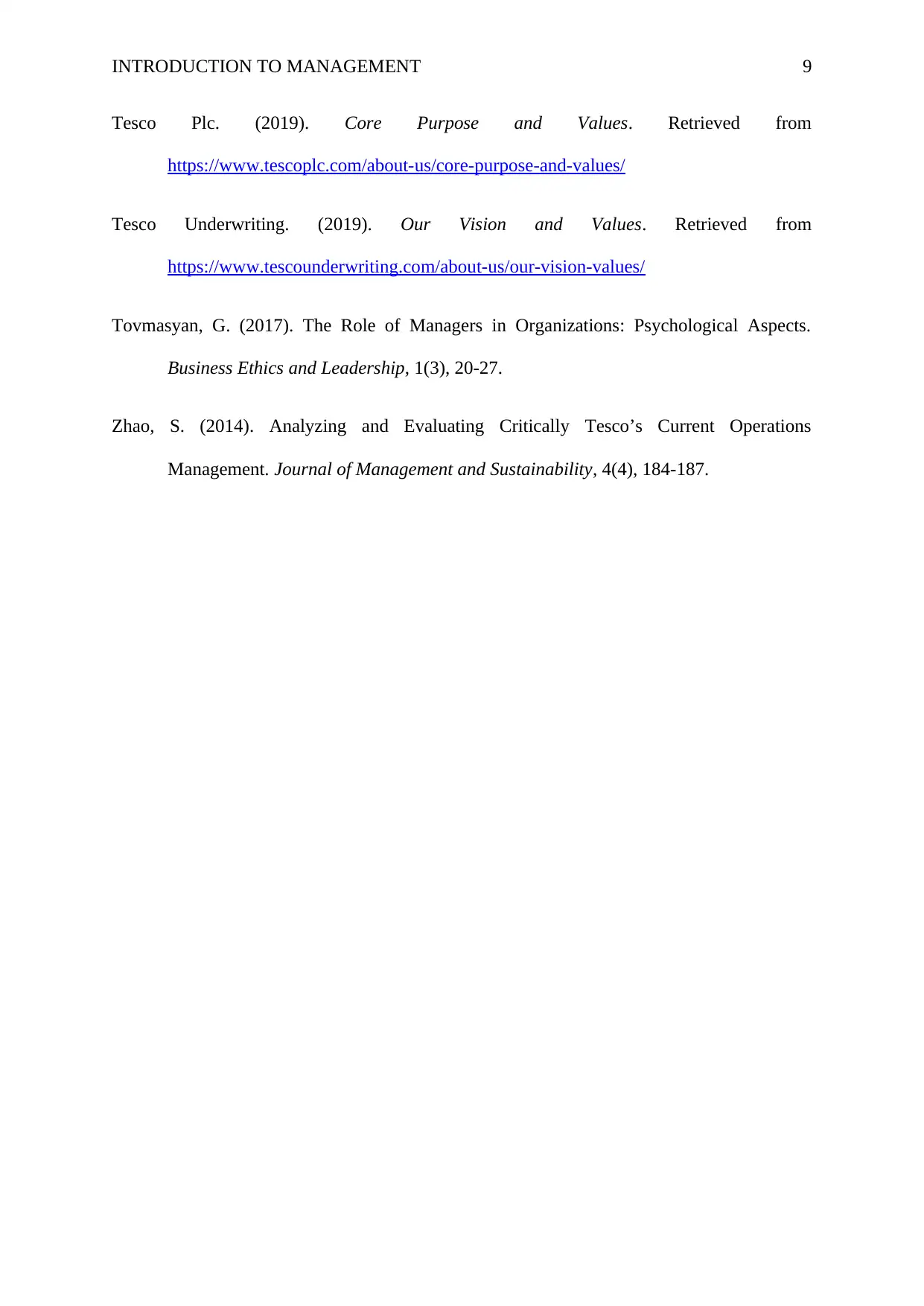
INTRODUCTION TO MANAGEMENT 9
Tesco Plc. (2019). Core Purpose and Values. Retrieved from
https://www.tescoplc.com/about-us/core-purpose-and-values/
Tesco Underwriting. (2019). Our Vision and Values. Retrieved from
https://www.tescounderwriting.com/about-us/our-vision-values/
Tovmasyan, G. (2017). The Role of Managers in Organizations: Psychological Aspects.
Business Ethics and Leadership, 1(3), 20-27.
Zhao, S. (2014). Analyzing and Evaluating Critically Tesco’s Current Operations
Management. Journal of Management and Sustainability, 4(4), 184-187.
Tesco Plc. (2019). Core Purpose and Values. Retrieved from
https://www.tescoplc.com/about-us/core-purpose-and-values/
Tesco Underwriting. (2019). Our Vision and Values. Retrieved from
https://www.tescounderwriting.com/about-us/our-vision-values/
Tovmasyan, G. (2017). The Role of Managers in Organizations: Psychological Aspects.
Business Ethics and Leadership, 1(3), 20-27.
Zhao, S. (2014). Analyzing and Evaluating Critically Tesco’s Current Operations
Management. Journal of Management and Sustainability, 4(4), 184-187.
1 out of 10
Related Documents
Your All-in-One AI-Powered Toolkit for Academic Success.
+13062052269
info@desklib.com
Available 24*7 on WhatsApp / Email
![[object Object]](/_next/static/media/star-bottom.7253800d.svg)
Unlock your academic potential
Copyright © 2020–2025 A2Z Services. All Rights Reserved. Developed and managed by ZUCOL.




